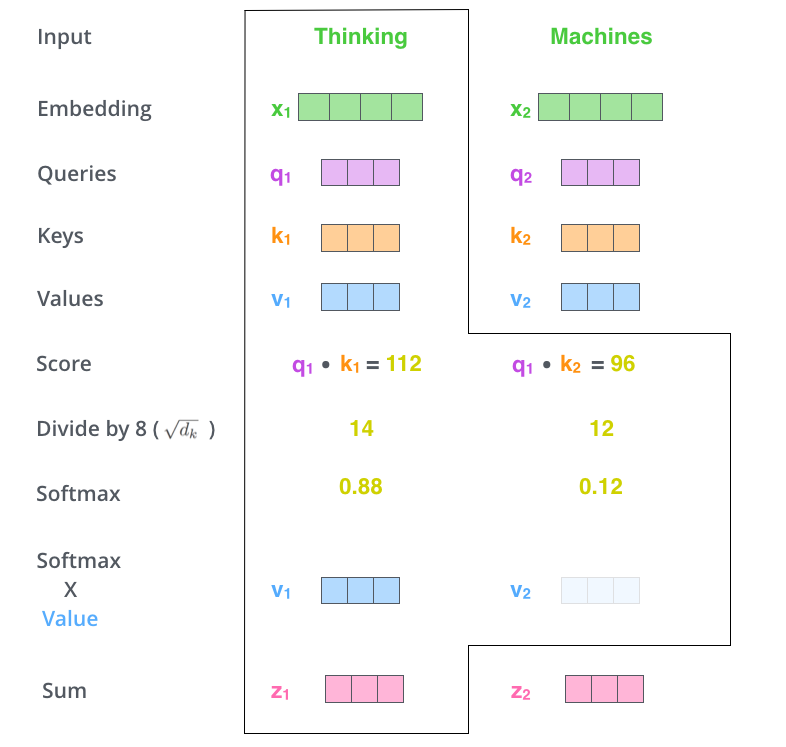I'm implementing an LLM from scratch, one component at a time.
- Download and install Miniforge
https://github.com/fastai/fastsetup/blob/master/setup-conda.sh
- Create new virtual environment
conda create -n llms python=3.10conda activate llms- Install required python packages
pip install -r requirements.txt- Building
- Pretraining
- Finetuning
Tokenization means converting the raw text as a string to some sequence of integers according to some vocabulary of possible elements
To get started I'm using the tiny_shakespeare dataset. a simple tokeniser implementation could be at the character level or word level.
with open('input.txt', 'r', encoding='utf-8') as f:
text = f.read()
print("number of characters: ", len(text))
print(text[:200])number of characters: 1115394
First Citizen:
Before we proceed any further, hear me speak.
All:
Speak, speak.
First Citizen:
You are all resolved rather to die than to famish?
All:
Resolved. resolved.
First Citizen:
First, you know Caius Marcius is chief enemy to the people.
All:
We know't, we know't.
First Citizen:
Let us kill him, and we'll have corn at our own price.
Is't a verdict?
All:
No more talking on't; let it be done: away, away!
Second Citizen:
One word, good citizens.
First Citizen:
We are accounted poor
Get a list of all the unique characters in our dataset.
vocab = sorted(list(set(text)))Let's build a simple character-level tokenizer with encode and decode methods.
class tokenizer:
def __init__(self, vocab):
self.stoi = { ch:i for i,ch in enumerate(vocab) }
self.itos = { i:ch for i,ch in enumerate(vocab) }
def encode(self, text):
ids = [self.stoi[c] for c in text]
return ids
def decode(self, ids):
text = ''.join([self.itos[i] for i in ids])
return textI'm initiating the tokenizer and trying our encoder and decoder.
tokenizer = Tokenizer(text)
text = """we are building an agi"""
print(tokenizer.encode(text))
print(tokenizer.decode(ids))[0, 5, 18, 16, 4, 5, 18, 7, 8, 12, 10, 11, 12, 17, 14, 18, 16, 17, 18, 16, 14, 12]
we are building an agiwe can also add special tokens like |end_of_text|, |reserved_special_token_0|
I'm using tiktoken library which uses a byte pair encoding(BPE) algorithm for tokenization. Andrej Karpathy has a clean implementation of the BPE algorithm.
import tiktoken
enc = tiktoken.get_encoding("o200k_base")we can encode and decode
text = "we are building an agi"
ids = enc.encode(text)
print(ids)
print(enc.decode(ids))[854, 553, 6282, 448, 1017, 72]
we are building an agi
How does tiktoken handles unknown words (out of vocab)? the algorithm breaks down the ou of vocab words into subword units or even at character level. See it in action here.
Andrej has a YouTube video on the BPE.
I'm using PyTorch classes Dataset and DataLoader. A custom Dataset class must implement three functions: init, len, and getitem.
import torch
from torch.utils.data import Dataset, DataLoader
class CustomDataset(Dataset):
def __init__(self, text, tokenizer, block_size, stride):
self.x = []
self.y = []
token_ids = tokenizer.encode(text)
for i in range(0, len(token_ids) - block_size, stride):
input = token_ids[i:i + block_size]
target = token_ids[i + 1:i + block_size + 1]
self.x.append(torch.tensor(input))
self.y.append(torch.tensor(target))I'm creating a PyTorch dataloader to load the data in batches.
block_size = 4 # what is the maximum context length for predictions?
batch_size = 1 # how many independent sequences will we process in parallel?
stride = 1 # how many positions the input shifts across batches?
data = CustomDataset(text, tokenizer, block_size, stride)
train_dataloader = DataLoader(dataset=data,
batch_size=batch_size,
num_workers=1,
shuffle=True)see the input and target
data_iter = iter(train_dataloader)
x, y = next(data_iter)
print("inputs:")
print(x)
print("targets:")
print(y)inputs:
tensor([[ 10652, 70176, 412, 59509],
[ 11062, 290, 77689, 198],
[ 889, 357, 1715, 10304],
[ 1632, 15939, 54659, 1076],
[ 484, 37510, 413, 75843],
[ 32618, 11, 357, 198],
[157223, 198, 197964, 12698],
[ 1661, 11, 1954, 501]])
targets:
tensor([[ 70176, 412, 59509, 113080],
[ 290, 77689, 198, 2566],
[ 357, 1715, 10304, 1262],
[ 15939, 54659, 1076, 364],
[ 37510, 413, 75843, 261],
[ 11, 357, 198, 4117],
[ 198, 197964, 12698, 306],
[ 11, 1954, 501, 32195]])
I'm using an inbuilt pytorch module nn.Embedding. This layer works like a lookup operation. For example, in the input sequence if we want to get an embedding for the token_id 5, look into the 6th row of input_embedding_matrix and pluck the row out. That's the embedding for token_id 5.
vocab_size = 50257
output_dim = 256 # GPT3 uses 12,288 dim
embedding_layer = torch.nn.Embedding(vocab_size, output_dim)
token_embeddings = embedding_layer(x)in original paper these are fixed but since GPT2 these are like regular parameters that are learned in training
context_length = max_length
pos_embedding_layer = torch.nn.Embedding(context_length, output_dim)
pos_embeddings = pos_embedding_layer(torch.arange(context_length)) # 0 1 ... max_length-1token embeddings are then added to the positional embeddings to get the final input embeddings
input_embeddings = token_embeddings + pos_embeddingsattention mechanism is the aggregation/reduce function
self-attention mechanism allows each token to attend to tokens in all other positions and it works as follows:
step 1: calculate attention scores by taking dot product of current token (query) with all the other tokens (keys)
step 2: use softmax to normalize each attention scores (generally done for training stability)
step 3: multiply input embeddings with attention scores and then sum up all the resulting vectors
Note
query => what i am looking for
key => what do i contain
value => if you find me interesting heres what i am communicating to you
this is vanilla self-attention. there're further optimized versions to it. causal attention that masks the future tokens and multi-head attention that distributed causal attention to multiple heads.
